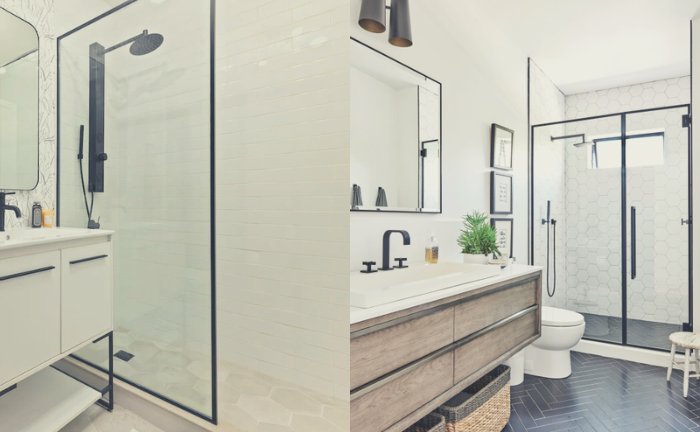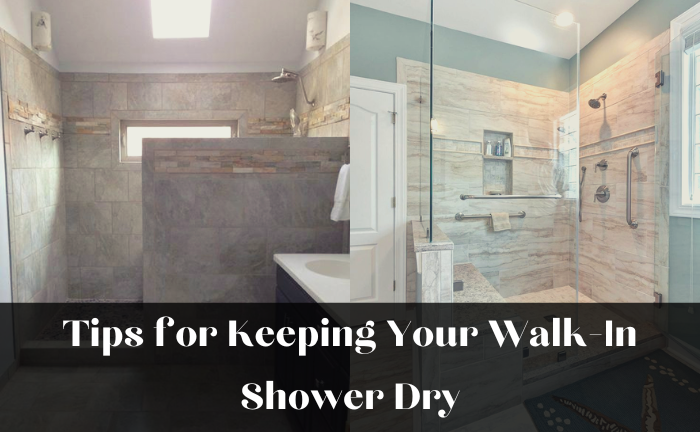If you’re renovating or building a new bathroom, you may consider a walk-in shower. Walk-in showers are becoming increasingly popular as they provide a modern, sleek look and make a bathroom feel more spacious.
You must be thinking that walk-in showers get water everywhere. Well, it’s a No. Walk-in showers do not necessarily get water everywhere. However, several factors can contribute to water dispersion in a walk-in shower.
So, without further ado, let’s go into the writing and explore more.
Factors To Consider

Here are a few fundamental factors to consider that can save your walk-in shower from leaking out.
The Slope of the Floor

The slope of the floor is an essential factor in preventing water from spreading throughout the bathroom. The floor should slope slightly toward the drain to ensure that water flows in that direction.
If the slope is too steep, water may splash out of the shower area and onto the bathroom floor.
If the slope is too gentle, water may pool in certain areas and create standing water, which can be a breeding ground for bacteria and mold.
Sealing the Shower Properly

One of the most important things to ensure is that your walk-in shower is sealed correctly. Proper sealing prevents water from leaking from the shower and onto the bathroom floor.
You can hire a professional to seal your shower, or you can do it yourself using a sealant.
Choose the Right Showerhead

The type of showerhead you choose can also impact how much water splashes around your bathroom. If you’re concerned about water getting everywhere, consider a showerhead with a lower flow rate.
Low-flow showerheads use less water and can help keep moisture in the shower where it belongs.
Size of the Shower

The size of the shower can also play a role in water dispersion. If the shower is too small, it may be challenging to move around and avoid splashing water outside of the shower area.
On the other hand, if the shower is too large, it may not be easy to slope the floor properly and ensure that water flows toward the drain.
Install a Shower Curtain or Door

Another way to keep water from splashing around your bathroom is to install a shower curtain or door. Shower curtains are an affordable option and available in various materials and styles.
Shower doors are more expensive but offer a more streamlined, modern look.
Consider the Shower’s Design

The design of your walk-in shower can also impact how much water splashes around your bathroom. A shower with a low threshold or no threshold can make it easier for water to escape the shower.
A shower with a higher threshold can help contain water in the shower.
Use a Bath Mat

Using a bath mat outside your shower can help absorb any water that may have escaped the shower. Bath mats are available in a variety of colors and styles and can add a pop of color to your bathroom while keeping your floors dry.
Maintain Your Shower

Regular maintenance of your walk-in shower can also help prevent water from getting everywhere. Keeping the shower clean and free of debris can prevent water from pooling in areas and potentially leaking out of the shower.
Additionally, inspecting the shower’s seals and grout for any cracks or damage can help catch potential issues before they become more significant problems.
Tips for Keeping Your Walk-In Shower Dry

Walk-in showers are a great addition to any bathroom, providing a modern and spacious feel. However, they also require extra care and attention to keep them dry and clean.
Here are some tips and tricks to help you maintain a dry and hygienic walk-in shower.
Use a Squeegee After Every Use

After you shower, use a squeegee to remove any excess water from the shower’s walls and floor. This will prevent water from accumulating and leaving unsightly water stains, as well as reduce the risk of mold and mildew growth.
Install a High-Quality Shower Curtain or Door

A high-quality shower curtain or door is essential for keeping water inside the shower and preventing it from splashing out onto the bathroom floor. Choose a product that fits your shower correctly and is made from a waterproof and durable material.
Ensure Proper Ventilation

Proper ventilation is crucial for preventing moisture buildup and promoting air circulation in your bathroom. Install a fan or open a window to help vent out steam and moisture after you finish showering. Besides, clean your fan regularly to prevent dust and dirt buildup.
Choose Non-Slip Flooring

Slippery floors are a safety hazard, especially in a wet and humid environment like a shower. Choose a non-slip flooring material, such as textured tiles or a rubber mat, to reduce the risk of slips and falls.
Clean Your Shower Regularly

Regular cleaning is essential for maintaining a clean and hygienic shower. Use a mild cleaner and a soft brush or sponge to scrub the walls and floor of the shower. Additionally, clean the drain regularly to prevent clogs and buildup.
Dry the Shower Thoroughly

After cleaning your shower, make sure to dry it thoroughly with a towel or cloth. This will prevent leftover moisture from accumulating and create a damp environment promoting mold and mildew growth.
Address Leaks and Water Damage

If you notice any leaks or water damage in your shower, it’s essential to address them immediately. Leaks can lead to water damage and mold growth, which can be costly and difficult to fix. Contact a professional if you need help with repairs.
Use a Water-Repellent Coating

Water-repellent coatings can help keep your shower dry and prevent water from penetrating the grout and causing damage. Choose a product that is specifically designed for use in showers and follow the manufacturer’s instructions carefully.
Advantages of walk-in showers
Walk-in showers offer many advantages over traditional showers.
- They are more accessible, making them an excellent choice for people with mobility issues or disabilities.
- They are easy to clean since there are no tracks or crevices where dirt and grime can accumulate.
- They create an open, spacious feel in the bathroom, which can make the room appear larger.
- They add value to your home and are a desirable feature for potential buyers.
Final Thoughts
In conclusion, while walk-in showers do have the potential to get water everywhere, proper design, installation, and maintenance can go a long way in preventing this from happening. If you’re considering a walk-in shower for your bathroom, be sure to consult with a professional installer to ensure that your shower is installed correctly and will function as intended.
